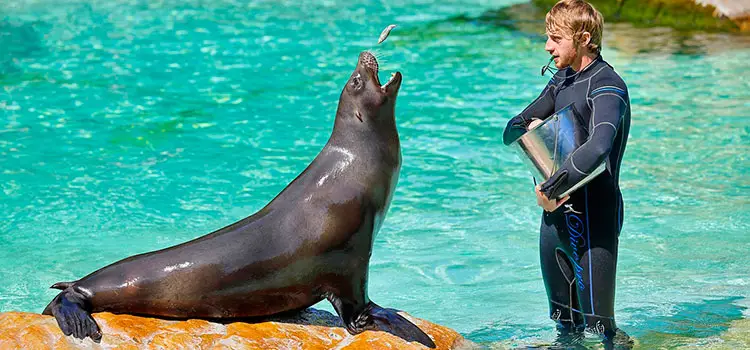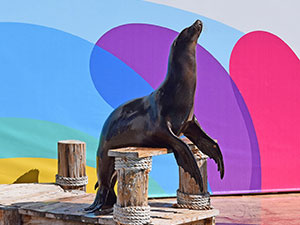
Just like our camera and other gadgets turning to low battery, my daughter’s energy is starting to wear out. However, that won’t stop her from seeing and discovering another marine mammals. If you haven’t read my previous article about her dolphin encounter then you can read it here. As you continue to read my post, you will learn interesting facts about our next marine mammals just like how my daughter gained knowledge about it.
The world’s oceans are home to a diverse array of captivating marine life, and among them, sea lions stand out with their charming demeanor and remarkable adaptations. Sea lions are also fascinating marine mammals that belong to the family Otariidae. Just like dolphins, sea lions are highly trainable and often used in marine mammal training programs similar to dolphins.
Their high intelligence, social nature, and ability to learn complex behaviors make them well-suited for training. They are known for their distinctive features, playful behavior, and remarkable adaptability to aquatic environments.
The Sea Lion Show
I recorded tons of their videos but I can’t upload them all here. Let me just share with you the best one. Forgive me about the quality of the video ‘cause I only used my phone.
In this show, trained sea lions typically showcased a variety of behaviors and tricks that demonstrate their intelligence, agility, and close interaction with their trainers. They performed acrobatics, jumps, flips, balancing acts, and various other engaging behaviors. These performances incorporated elements of education, conservation messaging, and audience participation to promote awareness and appreciation for sea lions and their marine habitats.
Sea lion shows provided educational and entertaining experiences for audiences of all ages. This was also highlighting the natural behaviors and capabilities of these remarkable marine mammals and the importance of protecting their wild counterparts and ocean environments.
Here are more fun facts and an overview of key information about sea lions.
Physical Characteristics

Size and Weight
Sea lions are large animals, with males being significantly larger than females. Adult males can reach lengths of 6 to 8 feet (1.8 to 2.4 meters) and weigh between 600 to 2,500 pounds (270 to 1,134 kilograms). Females are slightly smaller, measuring around 5 to 7 feet (1.5 to 2.1 meters) in length and weighing between 200 to 700 pounds (90 to 317 kilograms).
Appearance
Sea lions have streamlined bodies with elongated necks and powerful flippers. Their fur is short and dense, often varying in color from light brown to dark gray. Males typically have a thicker neck and a prominent mane, giving them a distinct appearance compared to females.
Habitat and Distribution
Range
Sea lions can be found in coastal waters worldwide, primarily in the northern and southern hemispheres. They inhabit regions of the Pacific Ocean, including North America, South America, Australia, and the Galapagos Islands.
Preferred Environments
Sea lions inhabit rocky shorelines, sandy beaches, and protected bays. They also frequent offshore islands and haul-out sites, where they rest, breed, and socialize.
Behavior and Social Structure
Agile Swimmers
Sea lions are highly adapted for swimming, using their powerful front flippers to propel themselves through the water. They are known for their acrobatic abilities, often leaping out of the water and performing various aerial maneuvers.
Group Dynamics
Sea lions are social animals and often gather in colonies or rookeries, which can range from a few individuals to thousands. Within colonies, dominant males establish territories and mate with multiple females. They are known for their loud barks and vocalizations, used for communication.
Feeding Habits
Sea lions are opportunistic carnivores, primarily feeding on fish such as herring, anchovies, and squid. They are skilled hunters and can dive to considerable depths in search of prey.
Life Cycle and Reproduction
Breeding Season
Sea lions have a well-defined breeding season, typically occurring in the summer months. During this time, males establish territories on land and engage in aggressive displays to attract females.
Pupping and Maternal Care
Female sea lions give birth to a single pup on land or on rocky shores. The pups are born with a black or dark brown coat and remain dependent on their mothers for nourishment and protection for several months. Mothers recognize their pups through vocal and scent cues.
Lifespan
Sea lions have an average lifespan of around 15 to 25 years, although some individuals have been known to live longer in captivity.
Conservation Status
Threats
Sea lions face various threats in their natural habitat, including pollution, habitat degradation, entanglement in fishing gear, and competition for food resources. They are also susceptible to climate change effects, such as rising sea temperatures and changes in prey availability.
Protected Species
Different species of sea lions have varying conservation statuses. For example, the California sea lion (Zalophus californianus) is listed as Least Concern by the International Union for Conservation of Nature (IUCN), while other species like the Galapagos sea lion (Zalophus wollebaeki) are considered Endangered.
Sea lions are captivating creatures with a strong affinity for the ocean. Their unique adaptations and social behaviors make them an integral part of marine ecosystems, highlighting the importance
Conclusion
Sea lions are captivating marine creatures that captivate our hearts with their playful nature and unique adaptations. By delving into their world and understanding their challenges, we can foster a sense of responsibility towards their conservation. Let us appreciate these charismatic animals and work together to protect their habitats and ensure their survival for generations to come.

Leave a Reply